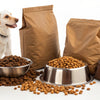Why Won't My Dog Eat Kibble Anymore? Understanding Your Dog's Feeding Habits
- Houndsy
Table of Contents
- Introduction
- Understanding the Importance of Kibble
- Common Reasons Dogs Refuse Kibble
- Addressing the Problem: Solutions to Entice Your Dog
- The Role of Quality in Dog Food
- Conclusion
Introduction
Imagine this: You’ve just filled your dog’s bowl with their favorite kibble, but instead of diving in, they turn their nose up and saunter away. It's a baffling scenario that many pet owners face. According to the American Kennel Club, a sudden change in a dog's eating habits can signal underlying issues that require attention. If you’re wondering, “Why won’t my dog eat kibble anymore?” you’re not alone.
The significance of a dog’s feeding routine goes beyond mere sustenance; it affects their health, mood, and overall well-being. For dog owners, understanding shifts in appetite is crucial to maintaining a happy and healthy pet. In this blog post, we will explore various reasons why dogs may refuse kibble, discuss potential health implications, and offer practical solutions to entice your furry friend back to their bowl.
By the end of this article, you’ll gain insights that will help you make informed decisions regarding your dog’s diet, ensuring their feeding experience is as enjoyable and nutritious as possible. Let’s embark on this journey together, reflecting on our own feeding routines and their impact on our beloved pets.
Understanding the Importance of Kibble
Kibble has long been a staple in dog diets, offering convenience and balanced nutrition. It is designed to provide essential nutrients while being easy to store and serve. However, the relationship between dogs and their food is complex. Dogs are creatures of habit, and any disruption can lead to changes in their eating behavior.
Nutritional Value of Kibble
High-quality kibble is formulated to meet the dietary needs of dogs at various life stages, from puppies to seniors. It typically contains:
- Proteins: Essential for muscle growth and repair.
- Fats: Provide energy and support healthy skin and coat.
- Carbohydrates: Serve as a source of energy and aid digestion.
- Vitamins and Minerals: Necessary for optimal health and immune function.
However, not all kibble is created equal. The quality of ingredients and nutritional balance can vary significantly, which is why it's crucial to choose a reputable brand. At Houndsy, we understand the importance of quality and design in pet care, which is why our flagship product, the Houndsy Kibble Dispenser, helps ensure your dog receives the right portions of high-quality kibble consistently.
Common Reasons Dogs Refuse Kibble
When we notice our furry companions turning their backs on their kibble, it prompts a deeper inquiry into the potential reasons behind their sudden pickiness. Here are some common factors that might contribute to this behavior:
1. Health Issues
Dental Problems: Just like us, dogs can suffer from dental issues. If your dog has a sore tooth or gum disease, the hard texture of kibble may be uncomfortable to chew. Regular dental check-ups can help identify and address these problems before they affect your dog's eating habits.
Gastrointestinal Distress: Upset stomachs, nausea, or other gastrointestinal issues can lead to a loss of appetite. If your dog’s refusal to eat kibble is accompanied by symptoms like vomiting or diarrhea, it’s essential to consult a veterinarian.
Underlying Illnesses: Conditions such as kidney disease, diabetes, or even cancer can manifest as changes in appetite. If your dog suddenly stops eating their usual food and shows other concerning symptoms, seeking veterinary advice is crucial.
2. Behavioral Factors
Anxiety and Stress: Dogs are sensitive creatures who thrive on routine. Changes in their environment, such as moving to a new home, the introduction of a new pet, or even loud noises can cause anxiety, leading to a reluctance to eat. Creating a calm feeding environment can help alleviate this issue.
Picky Eating Habits: Some dogs may develop a preference for more flavorful or moist foods. If you’ve occasionally indulged your dog with table scraps or wet food, they might turn their nose up at plain kibble. This can lead to a pattern of pickiness that can be challenging to break.
Overfeeding: If your dog is receiving too many treats or snacks throughout the day, they may not feel hungry at mealtime. Monitoring their overall caloric intake is important for maintaining a healthy appetite.
3. Food Quality and Freshness
Outdated Kibble: Just like any food, kibble has a shelf life. If your dog’s kibble is past its expiration date or has been stored improperly, it may lose flavor and nutritional value. Always check the packaging for freshness dates and store kibble in a cool, dry place.
Change in Formula: If the kibble's manufacturer has changed its recipe, your dog might not like the new taste or texture. If you’re switching brands or types, do it gradually to help your dog adjust.
4. Age-Related Changes
As dogs age, their dietary needs and preferences can shift. Older dogs may experience a decrease in their sense of smell, making food less appealing. Additionally, joint pain or decreased energy levels can make eating less enjoyable. It’s important to tailor your dog's diet to their life stage, ensuring it meets their evolving needs.
Addressing the Problem: Solutions to Entice Your Dog
Once we've identified potential reasons for our dog’s kibble aversion, we can explore practical strategies to encourage them to eat again.
1. Consult Your Veterinarian
Before making any significant changes to your dog’s diet, consulting with a veterinarian is key. They can help rule out any health concerns and provide tailored advice based on your dog’s specific needs.
2. Enhance the Kibble Experience
If your dog is simply being picky, there are several creative ways to make kibble more enticing:
- Mix-ins: Adding a small amount of wet food or bone broth can enhance the flavor and aroma of kibble, making it more appealing.
- Toppings: Consider adding safe fruits or vegetables like carrots or pumpkin. These not only add flavor but can also introduce new textures.
- Warm it Up: Slightly warming the kibble can intensify its aroma, making it more appetizing. Just ensure it’s not too hot!
3. Change the Environment
Creating a positive feeding environment can significantly influence your dog’s willingness to eat. Make sure the feeding area is quiet and free from distractions. Using a non-slip mat can also help if your dog struggles to eat from a bowl that moves around.
4. Gradual Food Transition
If you’re switching to a new kibble or food type, do it gradually over the course of a week. Mixing the new food with the old can help your dog adjust to the taste and texture without resistance.
5. Monitor Treats and Snacks
Be mindful of how many treats your dog consumes. Treats should only constitute about 10% of their daily caloric intake. Limiting treats can help ensure your dog is hungry enough to eat their kibble.
6. Use Interactive Feeding Tools
Engaging your dog with interactive feeding tools, such as puzzle feeders or the Houndsy Kibble Dispenser, can make mealtime exciting. These tools not only provide mental stimulation but also encourage dogs to work for their food, making the experience more rewarding.
The Role of Quality in Dog Food
At Houndsy, we understand the importance of quality and design in enhancing your dog’s feeding experience. Our flagship product, the Houndsy Kibble Dispenser, not only ensures perfect portion control but also maintains the freshness of your dog’s kibble with a BPA-free liner. Its mid-century modern design complements your home decor while providing ergonomic convenience for you.
When selecting kibble, always prioritize high-quality brands that offer balanced nutrition. Consider factors such as:
- Ingredient Quality: Look for real meat as the first ingredient, and avoid fillers and artificial preservatives.
- Nutritional Balance: Ensure the kibble meets the specific dietary needs for your dog’s age, size, and activity level.
- Brand Reputation: Research the brand’s history, safety standards, and customer reviews to ensure you’re making a wise choice.
Conclusion
Understanding why your dog won’t eat kibble anymore is a multifaceted challenge that requires careful observation and consideration. Whether it’s a health issue, behavioral change, or food quality, addressing the root cause is essential for restoring your dog’s appetite and happiness.
By consulting your veterinarian and implementing creative solutions to enhance your dog’s kibble experience, you can help them return to their regular feeding routine. Remember, our mission at Houndsy is to simplify and elevate the dog-feeding experience, ensuring that mealtime is nutritious, enjoyable, and aesthetically pleasing.
If you’re looking for a way to improve your dog’s feeding routine, consider exploring our Houndsy Kibble Dispenser. With its innovative design and functionality, it’s the perfect tool to make mealtime effortless and delightful for both you and your furry friend.
FAQ
Why has my dog suddenly stopped eating kibble?
There are several potential reasons, including health issues, changes in taste preferences, stress, or simply being picky. Always consult your veterinarian if the change in appetite is sudden and accompanied by other symptoms.
How can I entice my dog to eat their kibble again?
You can enhance the kibble's flavor with toppings, mix-ins, or by warming it slightly. Creating a calm feeding environment and using interactive feeding tools can also encourage eating.
Should I force my dog to eat if they refuse kibble?
No, forcing your dog to eat can lead to negative associations with mealtime. Instead, focus on improving the appeal of the food and consult your vet if the aversion persists.
How long can a dog go without eating before it becomes a concern?
While dogs can go without food for a few days, it’s crucial to monitor their hydration. If your dog hasn’t eaten for 24 hours or shows other concerning symptoms, contact your veterinarian immediately.
Is it okay to mix wet food with kibble?
Yes, mixing wet food with kibble can enhance the flavor and moisture content, making it more appealing to your dog. Just be sure to adjust portions to maintain balanced nutrition.
By engaging with your dog’s feeding habits and ensuring a nutritious diet, you contribute to their overall well-being and happiness. Together, let’s make mealtime a joyful experience for our beloved pets!













